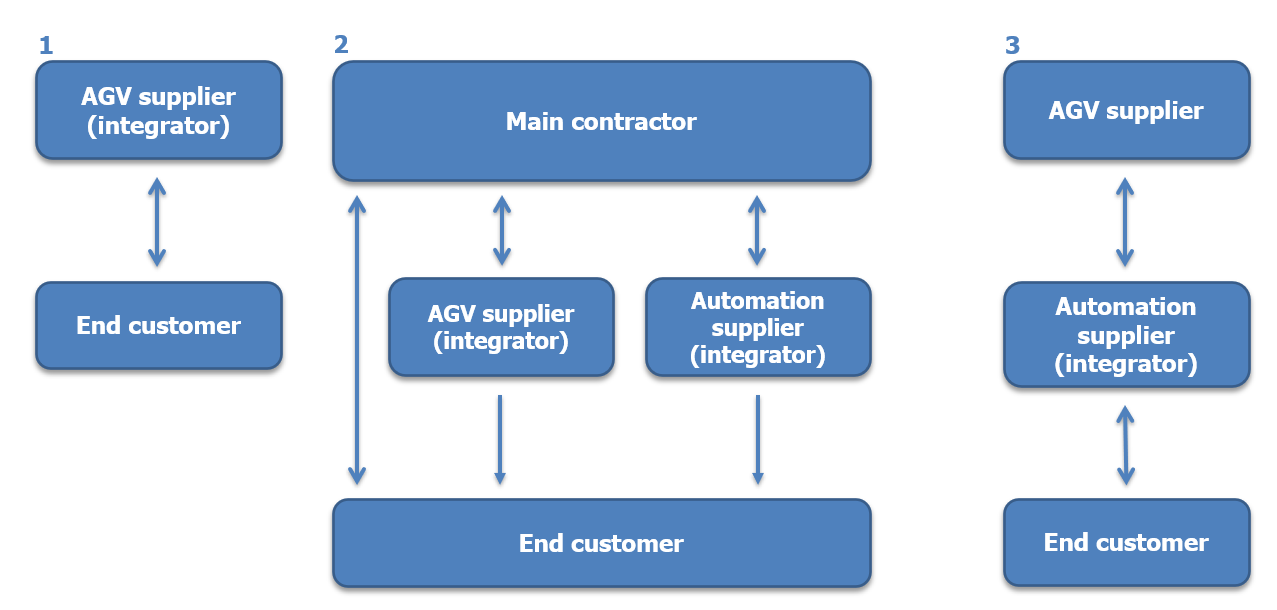What is an integrator?
Generally speaking, an AGV, AMR or automated forklift* integrator is any company that installs such solutions at a customer’s site. Installation is also called commissioning.
* Note: In this article, we use the term ‘AGV’ as a catch-all to describe all three categories of automated products.
The commissioning process is not merely about installing AGVs on-site, however. Often it also involves integrating these vehicles into a site’s existing systems. This could mean synchronizing the AGV’s fleet manager with your company’s existing WMS, MES or ERP software. It might also mean setting up communications – handshaking – between the fleet manager and on-site equipment such as automatic doors, elevators, palletizers and so on, in order that your AGV operation can run as planned.
In short, delivering, commissioning, and combining technologies, making sure these operate correctly together, is the integrator’s job.

What types of AGV integrators exist?
When it comes to which company actually commissions your AGVs on-site, there are different possibilities in today’s evolving market.
1. AGV manufacturers
In many cases today, automated vehicles are installed directly by their manufacturers. A typical use case here would be a manufacturing plant or logistics site that is already in operation (a so-called ‘brownfield’ site) and whose team now wants to install AGVs - either to kick off or supplement its automation program.
Installation by the manufacturer is often the approach with single-site projects. However, it is not always the case for larger sites or multiple-site automation projects. Here, the main contractor or ‘master integrator’ might define and then install all the required automation technologies themselves.
Examples: Oppent(IT), Movigo Robotics (NL) Eckhart (USA).
2. Third party, multi-brand AGV integrators
More and more companies are popping up that are purely concerned with the integration of AGVs, no matter what the brand. These firms offer and can install a range of vehicle types from different vehicle manufacturers.
Examples: Bastian Solutions (USA), ProLog Automation (DE).
3. Automation integrators
A lead or master automation integrator is employed to help define your entire automation strategy, proposing technologies and then, potentially, installing these on-site itself (including AGVs or AMRs). Automated vehicles are simply one more product in an integrator’s solutions offering.
Examples: AHS (USA), JAG (CH).
Blurring the lines
Of course, nothing in business is that simple, so the overview above might not apply in every case.
For example, an AGV manufacturer might be contracted directly by your automation project’s lead integrator. This master integrator might buy the vehicles directly from the AGV firm and include this cost in your overall project fee. While both companies’ teams might come on-site together - with the AGV maker possibly performing the commissioning – as the end customer, your company’s main relationship would remain with the lead integrator.
Three example scenarios Side trend: automation suppliers turning vehicle makers
Side trend: automation suppliers turning vehicle makers
When BlueBotics ran some numbers recently, its team calculated that around 30% of BlueBotics’ new customers – that is, companies developing vehicles based on its ANT navigation technology – are automation suppliers that want to add own-brand AGVs to their lineups.
These suppliers increasingly see AGVs and AMRs as a core component of a full automation portfolio. And since the rest of the technologies they supply are of similar or even greater complexity than automated vehicles, they have minimal fear about developing such solutions.
And a question: who maintains your AGVs?
When the same company is both producing an AGV and installing it, in most cases this company also handles the future maintenance of that system. There’s no reason to do anything else (unless your team is highly tech-savvy and able to handle all that themselves).
When your integrator is not the producer of the vehicle, however, the question of who maintains that vehicle and its software project is more fluid. In this situation, it will be important to dig into the details, so that you are 100% sure of who is responsible for what.
According to the AGV manufacturers we spoke with when writing this guide, on average an AGV user will look to change their project – adding vehicles, updating routes etc. – at least once a year. This work will typically be included within your AGV maintenance contract (whoever supplies that).
One possible scenario could be that, in future, the vehicle’s integrator takes care of general project maintenance (e.g., route updates) and provides your team with first-level support, while the AGV manufacturer provides second-level support and handles the maintenance of the vehicle itself.
As mentioned, the ‘who does what’ of such situations is an evolving topic, as the market grows and the integrator landscape becomes more defined.

